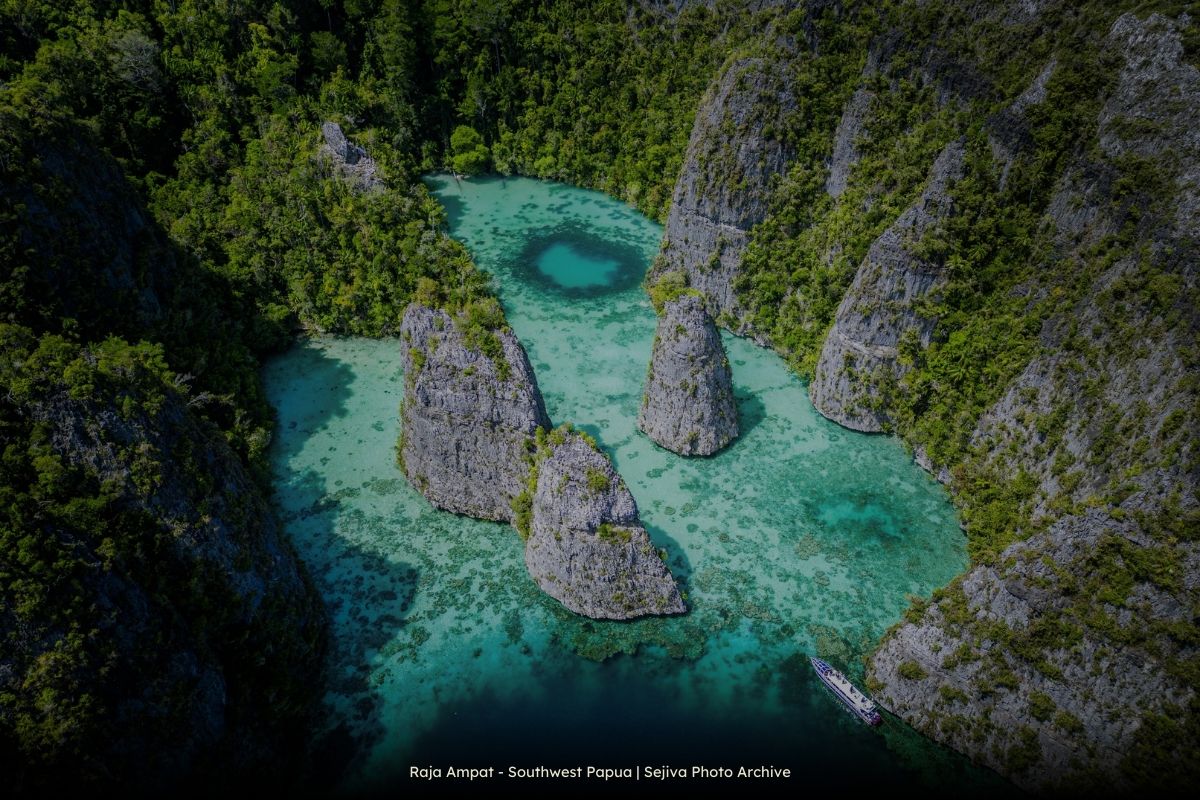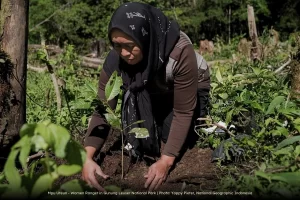Nestled in the remote corner of Papua, Indonesia, Raja Ampat has become a dream destination for travelers seeking untouched natural beauty and world-class marine adventures. Known as the “Crown Jewel of Indonesia’s islands”, Raja Ampat is a breathtaking paradise of turquoise waters, lush jungles, and extraordinary marine biodiversity, making it one of the most stunning eco-tourism destinations in the world.
Whether you’re an adventure seeker, a diver chasing vibrant coral reefs, or a traveler yearning for serene island life, Raja Ampat promises an unforgettable journey. This guide will help you explore the best of Raja Ampat Indonesia, from top attractions and hidden gems to travel tips for a sustainable visit.
where is raja ampat?
Raja Ampat is an archipelago located off the northwest tip of Bird’s Head Peninsula in West Papua, Indonesia. Comprising more than 1,500 small islands, cays, and shoals, the name “Raja Ampat” translates to “Four Kings,” referring to its four main islands: Misool, Salawati, Batanta, and Waigeo.
Each island offers something unique:
- Waigeo is the largest island, home to Waisai (the capital) and popular diving spots.
- Misool is renowned for its mystical caves, ancient rock paintings, and some of the richest reefs in the world.
- Batanta is perfect for trekking and exploring lush waterfalls.
- Salawati is less visited, making it ideal for travelers seeking solitude.
Its remote location makes it feel like a hidden paradise, untouched by mass tourism. Yet, this remoteness also adds to its charm, it’s a sanctuary for wildlife and a haven for travelers seeking a deeper connection with nature.
why is raja ampat special? (biodiversity & natural wonders)
Raja Ampat isn’t just beautiful, it’s a global hotspot for biodiversity. Often dubbed a diving paradise in Indonesia, it is home to over 1,500 species of fish, 600 species of coral, and countless marine creatures such as manta rays, pygmy seahorses, and reef sharks. These numbers make Raja Ampat part of the Coral Triangle, the most diverse marine ecosystem on the planet.
The archipelago also boasts dramatic karst landscapes, hidden lagoons, and mangrove forests. Wayag Island, with its iconic limestone islets rising from crystal-clear waters, is one of the most photographed spots in the region. Meanwhile, Misool Island is celebrated not only for its diving but also for its sacred caves adorned with prehistoric rock art.
No wonder Raja Ampat is listed on UNESCO’s Tentative World Heritage Sites for its outstanding universal value. Beyond marine life, its lush jungles are home to rare bird species like the Wilson’s bird-of-paradise, making it a haven for birdwatchers and wildlife photographers.
best things to do in raja ampat
Whether you’re exploring underwater wonders or immersing yourself in local traditions, Raja Ampat offers countless ways to experience its magic.
snorkeling & diving
Diving in Raja Ampat is nothing short of extraordinary. With crystal-clear waters, you’ll find yourself swimming alongside manta rays, sea turtles, and colorful schools of fish. Popular dive spots like Cape Kri, Manta Sandy, and Blue Magic are world-renowned for their vibrant reefs and diverse marine species.
Even if you’re not a diver, the snorkeling here is equally mesmerizing. Shallow reefs teeming with marine life make Raja Ampat one of the best places in the world for snorkelers.
Travelers can consider joining a liveaboard (diving cruise) for multi-day excursions to remote dive sites. It’s one of the best ways to maximize your underwater adventure.
island hopping
With over 1,500 islands, island hopping is a must. From the famous Wayag Island with its panoramic viewpoints to the secluded beaches of Misool Island, each stop promises a unique adventure.
Activities include:
- Kayaking through hidden lagoons
- Trekking to scenic viewpoints like Piaynemo and Wayag
- Relaxing on untouched white-sand beaches
Every island has a story to tell, and discovering them is part of Raja Ampat’s magic.
cultural encounters
Raja Ampat is not just about nature but also home to warm and welcoming indigenous Papuan communities. Visit local villages like Arborek to experience their rich culture, traditional dances, and artisanal crafts.
Engaging with locals adds depth to your journey while supporting the region’s community-based tourism efforts. Many villages offer homestays, giving travelers a chance to experience authentic Papuan hospitality.
best time to visit raja ampat
The best time to visit Raja Ampat Indonesia is between October and April, when seas are calm, visibility for diving is at its peak, and the weather is sunny with minimal rainfall. These months are ideal for water-based activities such as snorkeling, diving, and kayaking.
While Raja Ampat can be visited year-round, the monsoon season (May–September) may bring rough seas and occasional rain, which can affect travel between islands.
how to get there (travel tips & transportation)
Reaching Raja Ampat may require effort, but the journey is part of its allure.
- Fly to Sorong – The gateway to Raja Ampat is Domine Eduard Osok Airport in Sorong, reachable via Jakarta, Makassar, or Manado.
- Transfer by Ferry or Speedboat – From Sorong, travelers take a ferry or speedboat to Waisai, the capital of Raja Ampat Regency.
- Arrange Island Transfers – Many resorts and homestays offer private transfers to their locations.
Travel Tips:
- Pack light – Many islands have limited transportation options.
- Bring reef-safe sunscreen to protect marine ecosystems.
- Have enough cash – ATMs are limited outside Sorong.
- Book ahead – Especially for accommodations and liveaboards during peak season.
where to stay (eco-resorts & homestays)
Accommodation in Raja Ampat ranges from luxurious eco-resorts to budget-friendly homestays.
- Eco-Resorts: Options like Misool Eco Resort focus on sustainability, offering premium comfort while preserving the fragile environment.
- Homestays: Papuan-run homestays such as those in Arborek or Kri Island provide authentic cultural experiences at affordable prices.
For those seeking privacy, private villas and bungalows are also available. Regardless of your choice, early booking is highly recommended.
tips for sustainable travel in raja ampat
As one of the world’s most ecologically sensitive regions, Raja Ampat needs travelers who care about its preservation.
- Use Reef-Safe Sunscreen to protect corals from harmful chemicals.
- Support Local Communities by staying at Papuan-run homestays and purchasing local crafts.
- Respect Marine Life by avoiding physical contact with corals and not disturbing wildlife.
- Minimize Plastic Waste – Carry reusable bottles and bags to reduce pollution.
- Choose Eco-Friendly Operators – Prioritize tour operators who follow sustainable practices.
By traveling responsibly, you help ensure that Raja Ampat remains a thriving paradise for generations to come.
Raja Ampat is more than a destination, it’s a transformative experience. From the depths of its vibrant reefs to the warmth of its local communities, this remote paradise invites you to reconnect with nature and immerse yourself in Indonesia’s unparalleled beauty.
plan your raja ampat journey
Experiencing Raja Ampat is even more meaningful when done with purpose. We specialize in creating curated corporate retreats and wellness-focused journeys that go beyond typical travel experiences.
Imagine taking your team on a corporate retreat where mornings are spent snorkeling in pristine reefs, afternoons exploring cultural villages, and evenings reflecting by the sea. Our tailored trips combine adventure, team building, and well-being, designed to create lasting connections and rejuvenate your people.
Why travel to Raja Ampat with Us?
- Customized itineraries based on your group’s needs.
- Sustainable travel practices that respect local communities and the environment.
- Holistic retreat experiences blending exploration, mindfulness, and team growth.
Let Us craft your next transformative journey, because Raja Ampat isn’t just a destination, it’s an experience that will inspire your people long after the trip ends.










